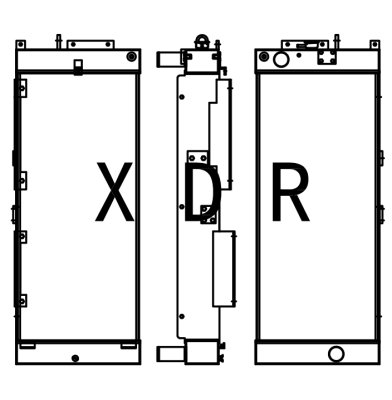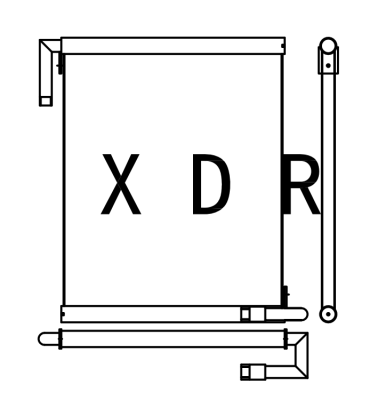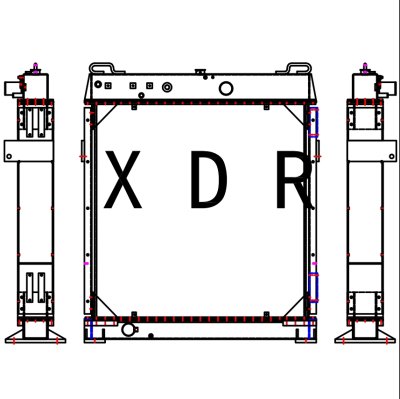How to maintain the radiator of a heavy excavator?
The radiator is a critical component in a heavy excavator, ensuring that the engine and hydraulic systems operate at optimal temperatures. Regular maintenance and proper care can significantly extend the life of the radiator, improve the reliability and performance of the excavator, and prevent costly breakdowns. Here’s a detailed guide on how to maintain the radiator of a heavy excavator:
1. Regular Cleaning
External Cleaning:
Tools: Soft brush, compressed air, low-pressure water hose.
Steps:
Turn Off the Engine and Let It Cool: Ensure the engine is completely cool before starting the cleaning process.
Remove Debris with a Soft Brush or Compressed Air: Gently brush or blow off dust, dirt, and debris from the radiator fins. Start from the top and work your way down to avoid damaging the fins.
Rinse with Low-Pressure Water (if needed): If using a water hose, set it to a low-pressure setting and rinse from top to bottom. High pressure can damage the radiator fins.
Internal Cleaning:
Tools: Radiator flush solution, soft hose.
Steps:
Drain the Coolant: Remove the old coolant from the radiator and cooling system.
Add Radiator Flush Solution: Follow the manufacturer's instructions to add the flush solution to the cooling system.
Run the Engine: Start the engine and let it run for a few minutes to circulate the flush solution.
Drain the Flush Solution and Old Coolant: After running the engine, drain the flush solution and any remaining old coolant.
Rinse Thoroughly with Clean Water: Use clean water to thoroughly rinse the cooling system until the water runs clear.
Refill with New Coolant: Add the recommended type and amount of new coolant to the system.
2. Check the Coolant
Tools: Coolant tester, funnel.
Steps:
Check Coolant Level: Regularly check the coolant level and ensure it is within the recommended range.
Test Coolant Quality: Use a coolant tester to check the concentration and quality of the coolant. If the coolant is contaminated or the concentration is incorrect, replace it.
Inspect Coolant Color and Clarity: Check the coolant for discoloration or sediment. If the coolant appears cloudy or has particles, it should be replaced.
3. Inspect the Fan and Belts
Tools: Flashlight, wrench.
Steps:
Check Fan Blades: Inspect the fan blades for cracks or damage. Replace the fan if any issues are found.
Check Fan Belt Tension and Condition: Ensure the fan belt is properly tensioned and not worn or cracked. Adjust or replace the belt as necessary.
Verify Alignment: Ensure the fan and pulleys are properly aligned and there are no unusual noises or vibrations.
4. Inspect Hoses and Connections
Tools: Flashlight, wrench.
Steps:
Check for Leaks: Inspect all hoses and connections for leaks, cracks, or loose fittings.
Tighten Connections: Ensure all connections are secure but not over-tightened, which can damage seals.
Replace Damaged Hoses: Replace any damaged or aged hoses and fittings.
5. Check Sensors and Control Units
Tools: Multimeter, diagnostic tool.
Steps:
Test Temperature Sensors: Verify that temperature sensors and other related sensors are functioning correctly.
Use Diagnostic Tools: Use a diagnostic tool to read any fault codes and address any issues with sensors or control units.
Ensure Electrical Connections: Check that all electrical connections are secure and free from corrosion.
6. Inspect the Radiator Cap
Tools: Pressure tester.
Steps:
Check for Damage: Inspect the radiator cap for any signs of damage or wear.
Test Pressure Release: Use a pressure tester to check the pressure release function of the radiator cap.
Replace if Necessary: Replace the radiator cap if it is damaged or not functioning properly.
7. Keep a Maintenance Log
Tools: Notebook or electronic record-keeping system.
Steps:
Record Maintenance Activities: Document the date, type, and details of each maintenance activity.
Track Coolant Changes: Keep a record of coolant changes, including the date and type of coolant used.
Log Repairs and Replacements: Record any repairs or replacements made, including the parts and the dates of the work.
By following these detailed maintenance steps, you can ensure that the radiator of your heavy excavator remains in excellent condition, improving the overall reliability and performance of the machine. Regular maintenance not only helps prevent failures but also reduces repair costs and ensures that the excavator operates efficiently in various working conditions.




